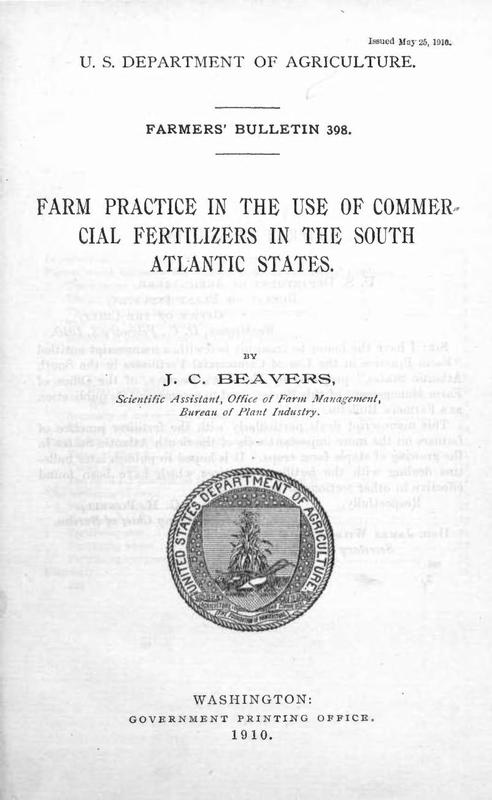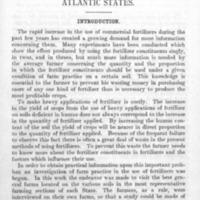Farm Practice in the Use of Commercial Fertilizers in the South Atlantic States
Creator
Date
1910
Subject
Excerpt
SUMMARY
(1) Commercial fertilizers are expensive. Accurate information is needed for their economic use.
(2) With a good rotation, deep and thorough tillage, and the use of green manures, legumes, and winter cover crops, the quantity of commercial fertilizers required for a given crop yield can be considerably reduced.
(3) The character of the soil has a marked influence on the quantity and kind of fertilizer it is necessary to use in a good system of farming.
(4) In farm practice there is a gradual increase in the quantity of all the fertilizer constituents required to produce like yields as the proportion of sand in the surface and subsoil increases. The increase is greatest in the quantity of potash necessary, followed by phosphoric acid, and then by nitrogen.
(5) A study of farm practice shows that the best farmers, those referred to in this bulletin as belonging to Class A, obtain yields of 1 to 2 bales of cotton, 40 to 75 bushels of corn, and 40 to 75 bushels of oats on soils where farmers of Class B get but one-half to 1 bale of cotton, 15 to 40 bushels of corn, and 15 to 40 bushels of oats, duo to the fact that the best farmers have a better understanding of the use of fertilizers and employ better farm methods.
(G) One of the most common grades of fertilizer on the market in the South Atlantic States at present contains 8 per cent of phosphoric acid, 3 per cent of ammonia, and 3 per cent of potash. This grade of fertilizer is of primary value only for cotton on red clay soil under fairly good methods of rotation. This fertilizer formula needs to be greatly modified for crops on sandy, sandy loam, and gray loam soils, and for all crops other than cotton on red clay soil.
(7) Detailed suggestions aro contained in this bulletin on the best method of fertilizing and the most profitable kinds of fertilizer constituents to apply on soils of different character to cotton, corn, oats, wheat, and cowpeas.
(1) Commercial fertilizers are expensive. Accurate information is needed for their economic use.
(2) With a good rotation, deep and thorough tillage, and the use of green manures, legumes, and winter cover crops, the quantity of commercial fertilizers required for a given crop yield can be considerably reduced.
(3) The character of the soil has a marked influence on the quantity and kind of fertilizer it is necessary to use in a good system of farming.
(4) In farm practice there is a gradual increase in the quantity of all the fertilizer constituents required to produce like yields as the proportion of sand in the surface and subsoil increases. The increase is greatest in the quantity of potash necessary, followed by phosphoric acid, and then by nitrogen.
(5) A study of farm practice shows that the best farmers, those referred to in this bulletin as belonging to Class A, obtain yields of 1 to 2 bales of cotton, 40 to 75 bushels of corn, and 40 to 75 bushels of oats on soils where farmers of Class B get but one-half to 1 bale of cotton, 15 to 40 bushels of corn, and 15 to 40 bushels of oats, duo to the fact that the best farmers have a better understanding of the use of fertilizers and employ better farm methods.
(G) One of the most common grades of fertilizer on the market in the South Atlantic States at present contains 8 per cent of phosphoric acid, 3 per cent of ammonia, and 3 per cent of potash. This grade of fertilizer is of primary value only for cotton on red clay soil under fairly good methods of rotation. This fertilizer formula needs to be greatly modified for crops on sandy, sandy loam, and gray loam soils, and for all crops other than cotton on red clay soil.
(7) Detailed suggestions aro contained in this bulletin on the best method of fertilizing and the most profitable kinds of fertilizer constituents to apply on soils of different character to cotton, corn, oats, wheat, and cowpeas.
Title
Farm Practice in the Use of Commercial Fertilizers in the South Atlantic States
File(s)
Commercial Fertilizers Cover.jpg
(image/jpeg)
Commercial Fertilizers TOC.jpg
(image/jpeg)
Commercial Fertilizers Introduction.jpg
(image/jpeg)
 An official website of the United States government.
An official website of the United States government.




